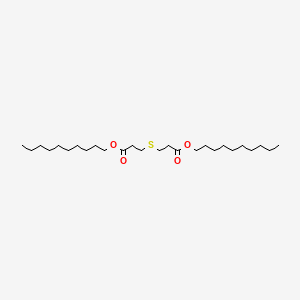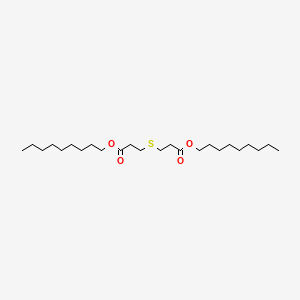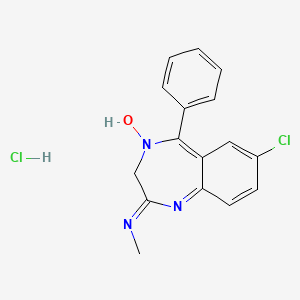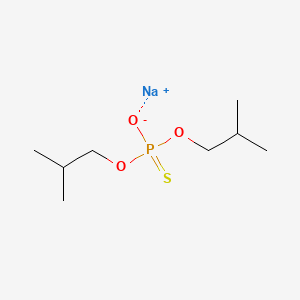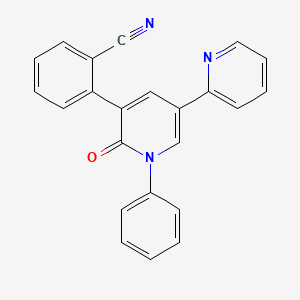
Perampanel
概要
説明
Perampanel is a novel antiepileptic drug that functions as a selective, non-competitive antagonist of the α-amino-3-hydroxy-5-methyl-4-isoxazolepropionic acid receptor. It is primarily used as an adjunctive therapy for the treatment of partial-onset seizures and primary generalized tonic-clonic seizures in patients with epilepsy . This compound is marketed under the brand name Fycompa and has been approved in over 35 countries .
作用機序
Target of Action
Perampanel is a non-competitive antagonist of the AMPA glutamate receptor . Glutamate is the primary neurotransmitter regulating excitatory synaptic transmission in the brain . The AMPA receptor is one of the ligand-gated ion channels for glutamate .
Mode of Action
It is specifically engineered to block glutamate activity at postsynaptic AMPA receptors .
Biochemical Pathways
This compound affects the up-stream regulatory pathways of GluA1 phosphorylation including protein kinase C (PKC), Ca2±calmodulin-dependent protein kinase II (CAMKII), protein kinase A (PKA), extracellular signal-regulated kinase 1/2 (ERK1/2), c-Jun N-terminal kinase (JNK), and protein phosphatase (PP) 1, PP2A, and PP2B . These proteins form receptor signaling complexes with AMPARs and can modulate their trafficking, opening, closing, desensitization, pharmacological properties, and permeability, providing fine-tuning of the AMPA receptor functions in space and time .
Pharmacokinetics
This compound is rapidly absorbed with Tmax values of 0.5–2.5 h and with a bioavailability of 100%. The volume of distribution is 1.1 L/kg and protein binding is 95% . This compound is highly metabolized by CYP3A4 and/or CYP3A5 primary oxidation and by sequential glucuronidation . This compound is eliminated mostly in the feces (48%) and to a lesser extent in the urine (22%) .
Result of Action
This compound has been shown to have antiproliferative effects on glioblastoma cell lines . It also significantly attenuated oxygen glucose deprivation (OGD)-induced loss of cell viability, release of lactate dehydrogenase, and apoptotic cell death in a dose-dependent manner . Furthermore, this compound has been reported to alleviate early brain injury following subarachnoid hemorrhage and traumatic brain injury by reducing reactive oxygen species, apoptosis, autophagy, and necroptosis .
Action Environment
Environmental factors such as iron overload can influence the action of this compound. Iron overload in the neonatal period induces persistent memory deficits and increases oxidative stress and apoptotic markers. The neuronal insult caused by iron excess generates an energetic imbalance that can alter glutamate concentrations and thus trigger excitotoxicity. This compound, as a reversible AMPA receptor antagonist, has been shown to improve memory in rodents subjected to iron overload in the neonatal period .
生化学分析
Biochemical Properties
Perampanel plays a crucial role in inhibiting neuronal excitation in the central nervous system by blocking AMPA receptors. These receptors are ligand-gated ion channels that mediate fast synaptic transmission in the central nervous system. By inhibiting these receptors, this compound reduces the excitatory neurotransmission that can lead to seizures . This compound interacts with various biomolecules, including proteins such as protein kinase C (PKC), Ca2±calmodulin-dependent protein kinase II (CAMKII), protein kinase A (PKA), extracellular signal-regulated kinase 1/2 (ERK1/2), and c-Jun N-terminal kinase (JNK) .
Cellular Effects
This compound affects various types of cells and cellular processes. It influences cell function by modulating cell signaling pathways, gene expression, and cellular metabolism. In normal and epileptic rats, this compound has been shown to affect the phosphorylation of GluA1, a subunit of the AMPA receptor, through the regulation of multiple molecules such as CAMKII, PKA, JNK, and protein phosphatase 2B (PP2B) . Additionally, this compound has been found to exert protective effects against traumatic brain injury by reducing neuronal apoptosis and inhibiting lipid peroxidation .
Molecular Mechanism
The molecular mechanism of this compound involves its action as a non-competitive antagonist of the AMPA receptor. By binding to a site distinct from the glutamate binding site, this compound inhibits the receptor’s activity, leading to decreased neuronal excitation . This inhibition is achieved through negative allosteric modulation, which prevents the receptor from undergoing the conformational changes necessary for ion channel opening . This compound’s effects on gene expression include the modulation of signaling pathways that regulate the phosphorylation of AMPA receptor subunits .
Temporal Effects in Laboratory Settings
In laboratory settings, the effects of this compound have been observed to change over time. This compound is stable and maintains its efficacy in reducing seizure activity over extended periods. In studies involving epileptic rats, this compound effectively inhibited spontaneous seizure activities and maintained its neuroprotective effects without negatively impacting cognitive abilities . Additionally, this compound has been shown to resolve status epilepticus within 24 hours in patients with inflammatory or autoimmune etiologies .
Dosage Effects in Animal Models
The effects of this compound vary with different dosages in animal models. In a rat model of chronic epilepsy, fully adherent rats demonstrated a significant reduction in seizure frequency with this compound treatment, while nonadherent rats experienced an increase in seizure frequency . High doses of this compound have been associated with adverse effects such as vomiting and decreased activity in beagle dogs . The therapeutic index of this compound is narrow, and optimal dosing strategies are essential to maximize its efficacy while minimizing adverse effects .
Metabolic Pathways
This compound is primarily metabolized by the cytochrome P450 enzymes CYP3A4 and CYP3A5 through oxidative metabolism and sequential glucuronidation . The drug is highly metabolized in the liver, and its metabolites are not pharmacologically active . The metabolic pathways of this compound involve interactions with enzymes that regulate its biotransformation and elimination .
Transport and Distribution
This compound is rapidly absorbed after oral ingestion, with a bioavailability of 100% and a volume of distribution of 1.1 L/kg . It is extensively bound to plasma proteins, primarily α1-acid glycoprotein and albumin . This compound undergoes extensive metabolism in the liver, and less than 0.12% of the administered dose is excreted unchanged in the urine . The drug is widely distributed throughout tissues, and its pharmacokinetics are influenced by the presence of enzyme-inducing antiseizure medications .
Subcellular Localization
The subcellular localization of this compound is primarily associated with its target, the AMPA receptor, which is located on the postsynaptic membranes of neurons . This compound’s activity is influenced by its ability to bind to the AMPA receptor and inhibit its function. The drug’s localization to specific subcellular compartments is essential for its therapeutic effects in reducing neuronal excitation and preventing seizures .
準備方法
The synthesis of perampanel involves several steps, starting with the protection of the hydroxyl group using an alkali-resistant protecting group such as dihydropyranyl or trityl . The intermediate is then subjected to various reaction conditions, including the use of p-toluenesulfonic acid monohydrate and dihydropyran, to obtain the final product . Industrial production methods typically involve high-performance liquid chromatography for the quantification and validation of this compound in plasma samples .
化学反応の分析
Perampanel undergoes several types of chemical reactions, including oxidation, reduction, and substitution. Common reagents used in these reactions include acetonitrile, methanol, and orthophosphoric acid . The major products formed from these reactions are typically analyzed using high-performance liquid chromatography and fluorescence detection .
科学的研究の応用
Perampanel has a wide range of scientific research applications, particularly in the fields of chemistry, biology, medicine, and industry. In medicine, it is used as an antiepileptic drug for the treatment of refractory partial-onset seizures and primary generalized tonic-clonic seizures . In biological research, this compound is studied for its anti-inflammatory and neuroprotective properties, particularly in the treatment of status epilepticus with suspected inflammatory etiology . Additionally, this compound is used in pharmacological research to study its effects on the α-amino-3-hydroxy-5-methyl-4-isoxazolepropionic acid receptor .
類似化合物との比較
Perampanel is unique among antiepileptic drugs due to its selective inhibition of the α-amino-3-hydroxy-5-methyl-4-isoxazolepropionic acid receptor . Similar compounds include other antiepileptic drugs that target different receptors, such as levetiracetam and lamotrigine . Unlike these drugs, this compound offers the convenience of once-daily administration and has been shown to provide sustained seizure control in patients with drug-resistant epilepsy .
特性
IUPAC Name |
2-(2-oxo-1-phenyl-5-pyridin-2-ylpyridin-3-yl)benzonitrile | |
|---|---|---|
| Details | Computed by Lexichem TK 2.7.0 (PubChem release 2021.05.07) | |
| Source | PubChem | |
| URL | https://pubchem.ncbi.nlm.nih.gov | |
| Description | Data deposited in or computed by PubChem | |
InChI |
InChI=1S/C23H15N3O/c24-15-17-8-4-5-11-20(17)21-14-18(22-12-6-7-13-25-22)16-26(23(21)27)19-9-2-1-3-10-19/h1-14,16H | |
| Details | Computed by InChI 1.0.6 (PubChem release 2021.05.07) | |
| Source | PubChem | |
| URL | https://pubchem.ncbi.nlm.nih.gov | |
| Description | Data deposited in or computed by PubChem | |
InChI Key |
PRMWGUBFXWROHD-UHFFFAOYSA-N | |
| Details | Computed by InChI 1.0.6 (PubChem release 2021.05.07) | |
| Source | PubChem | |
| URL | https://pubchem.ncbi.nlm.nih.gov | |
| Description | Data deposited in or computed by PubChem | |
Canonical SMILES |
C1=CC=C(C=C1)N2C=C(C=C(C2=O)C3=CC=CC=C3C#N)C4=CC=CC=N4 | |
| Details | Computed by OEChem 2.3.0 (PubChem release 2021.05.07) | |
| Source | PubChem | |
| URL | https://pubchem.ncbi.nlm.nih.gov | |
| Description | Data deposited in or computed by PubChem | |
Molecular Formula |
C23H15N3O | |
| Details | Computed by PubChem 2.1 (PubChem release 2021.05.07) | |
| Source | PubChem | |
| URL | https://pubchem.ncbi.nlm.nih.gov | |
| Description | Data deposited in or computed by PubChem | |
DSSTOX Substance ID |
DTXSID80191501 | |
| Record name | Perampanel | |
| Source | EPA DSSTox | |
| URL | https://comptox.epa.gov/dashboard/DTXSID80191501 | |
| Description | DSSTox provides a high quality public chemistry resource for supporting improved predictive toxicology. | |
Molecular Weight |
349.4 g/mol | |
| Details | Computed by PubChem 2.1 (PubChem release 2021.05.07) | |
| Source | PubChem | |
| URL | https://pubchem.ncbi.nlm.nih.gov | |
| Description | Data deposited in or computed by PubChem | |
Solubility |
Practically insoluble in water. | |
| Details | From FDA label. | |
| Record name | Perampanel | |
| Source | DrugBank | |
| URL | https://www.drugbank.ca/drugs/DB08883 | |
| Description | The DrugBank database is a unique bioinformatics and cheminformatics resource that combines detailed drug (i.e. chemical, pharmacological and pharmaceutical) data with comprehensive drug target (i.e. sequence, structure, and pathway) information. | |
| Explanation | Creative Common's Attribution-NonCommercial 4.0 International License (http://creativecommons.org/licenses/by-nc/4.0/legalcode) | |
Mechanism of Action |
The exact mechanism of action of perampanel in seizures is not yet determined, but it is known that perampanel decreases neuronal excitation by non-competitive ihibition of the AMPA receptor. | |
| Record name | Perampanel | |
| Source | DrugBank | |
| URL | https://www.drugbank.ca/drugs/DB08883 | |
| Description | The DrugBank database is a unique bioinformatics and cheminformatics resource that combines detailed drug (i.e. chemical, pharmacological and pharmaceutical) data with comprehensive drug target (i.e. sequence, structure, and pathway) information. | |
| Explanation | Creative Common's Attribution-NonCommercial 4.0 International License (http://creativecommons.org/licenses/by-nc/4.0/legalcode) | |
CAS No. |
380917-97-5 | |
| Record name | Perampanel | |
| Source | CAS Common Chemistry | |
| URL | https://commonchemistry.cas.org/detail?cas_rn=380917-97-5 | |
| Description | CAS Common Chemistry is an open community resource for accessing chemical information. Nearly 500,000 chemical substances from CAS REGISTRY cover areas of community interest, including common and frequently regulated chemicals, and those relevant to high school and undergraduate chemistry classes. This chemical information, curated by our expert scientists, is provided in alignment with our mission as a division of the American Chemical Society. | |
| Explanation | The data from CAS Common Chemistry is provided under a CC-BY-NC 4.0 license, unless otherwise stated. | |
| Record name | Perampanel [USAN:INN] | |
| Source | ChemIDplus | |
| URL | https://pubchem.ncbi.nlm.nih.gov/substance/?source=chemidplus&sourceid=0380917975 | |
| Description | ChemIDplus is a free, web search system that provides access to the structure and nomenclature authority files used for the identification of chemical substances cited in National Library of Medicine (NLM) databases, including the TOXNET system. | |
| Record name | Perampanel | |
| Source | DrugBank | |
| URL | https://www.drugbank.ca/drugs/DB08883 | |
| Description | The DrugBank database is a unique bioinformatics and cheminformatics resource that combines detailed drug (i.e. chemical, pharmacological and pharmaceutical) data with comprehensive drug target (i.e. sequence, structure, and pathway) information. | |
| Explanation | Creative Common's Attribution-NonCommercial 4.0 International License (http://creativecommons.org/licenses/by-nc/4.0/legalcode) | |
| Record name | Perampanel | |
| Source | EPA DSSTox | |
| URL | https://comptox.epa.gov/dashboard/DTXSID80191501 | |
| Description | DSSTox provides a high quality public chemistry resource for supporting improved predictive toxicology. | |
| Record name | 2-(2-oxo-1-phenyl-5-pyridin-2-yl-1,2-dihydropyridin-3-yl)benzonitrile hydrate(4:3) | |
| Source | European Chemicals Agency (ECHA) | |
| URL | https://echa.europa.eu/information-on-chemicals | |
| Description | The European Chemicals Agency (ECHA) is an agency of the European Union which is the driving force among regulatory authorities in implementing the EU's groundbreaking chemicals legislation for the benefit of human health and the environment as well as for innovation and competitiveness. | |
| Explanation | Use of the information, documents and data from the ECHA website is subject to the terms and conditions of this Legal Notice, and subject to other binding limitations provided for under applicable law, the information, documents and data made available on the ECHA website may be reproduced, distributed and/or used, totally or in part, for non-commercial purposes provided that ECHA is acknowledged as the source: "Source: European Chemicals Agency, http://echa.europa.eu/". Such acknowledgement must be included in each copy of the material. ECHA permits and encourages organisations and individuals to create links to the ECHA website under the following cumulative conditions: Links can only be made to webpages that provide a link to the Legal Notice page. | |
| Record name | PERAMPANEL | |
| Source | FDA Global Substance Registration System (GSRS) | |
| URL | https://gsrs.ncats.nih.gov/ginas/app/beta/substances/H821664NPK | |
| Description | The FDA Global Substance Registration System (GSRS) enables the efficient and accurate exchange of information on what substances are in regulated products. Instead of relying on names, which vary across regulatory domains, countries, and regions, the GSRS knowledge base makes it possible for substances to be defined by standardized, scientific descriptions. | |
| Explanation | Unless otherwise noted, the contents of the FDA website (www.fda.gov), both text and graphics, are not copyrighted. They are in the public domain and may be republished, reprinted and otherwise used freely by anyone without the need to obtain permission from FDA. Credit to the U.S. Food and Drug Administration as the source is appreciated but not required. | |
Synthesis routes and methods I
Procedure details










Synthesis routes and methods II
Procedure details







Retrosynthesis Analysis
AI-Powered Synthesis Planning: Our tool employs the Template_relevance Pistachio, Template_relevance Bkms_metabolic, Template_relevance Pistachio_ringbreaker, Template_relevance Reaxys, Template_relevance Reaxys_biocatalysis model, leveraging a vast database of chemical reactions to predict feasible synthetic routes.
One-Step Synthesis Focus: Specifically designed for one-step synthesis, it provides concise and direct routes for your target compounds, streamlining the synthesis process.
Accurate Predictions: Utilizing the extensive PISTACHIO, BKMS_METABOLIC, PISTACHIO_RINGBREAKER, REAXYS, REAXYS_BIOCATALYSIS database, our tool offers high-accuracy predictions, reflecting the latest in chemical research and data.
Strategy Settings
| Precursor scoring | Relevance Heuristic |
|---|---|
| Min. plausibility | 0.01 |
| Model | Template_relevance |
| Template Set | Pistachio/Bkms_metabolic/Pistachio_ringbreaker/Reaxys/Reaxys_biocatalysis |
| Top-N result to add to graph | 6 |
Feasible Synthetic Routes
試験管内研究製品の免責事項と情報
BenchChemで提示されるすべての記事および製品情報は、情報提供を目的としています。BenchChemで購入可能な製品は、生体外研究のために特別に設計されています。生体外研究は、ラテン語の "in glass" に由来し、生物体の外で行われる実験を指します。これらの製品は医薬品または薬として分類されておらず、FDAから任何の医療状態、病気、または疾患の予防、治療、または治癒のために承認されていません。これらの製品を人間または動物に体内に導入する形態は、法律により厳格に禁止されています。これらのガイドラインに従うことは、研究と実験において法的および倫理的な基準の遵守を確実にするために重要です。
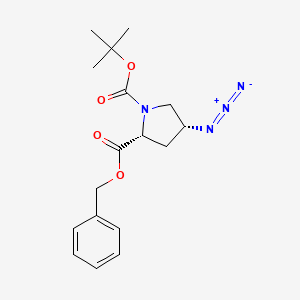

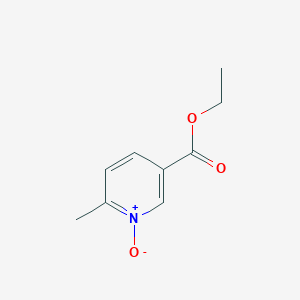
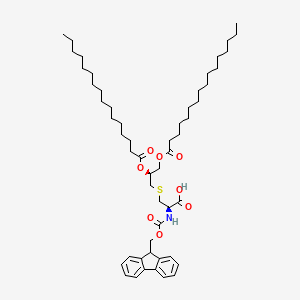
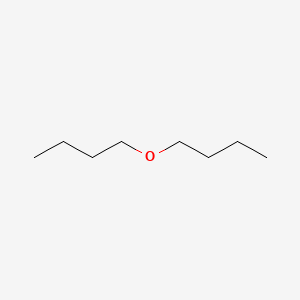
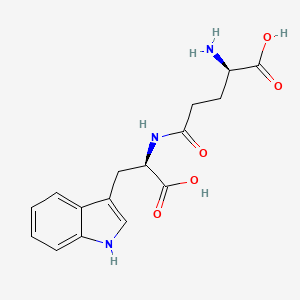
![4-Penten-1-one, 1-spiro[4.5]dec-7-en-7-yl-](/img/structure/B3395830.png)

![4-nitro-7-oxidothieno[2,3-b]pyridin-7-ium](/img/structure/B3395836.png)

